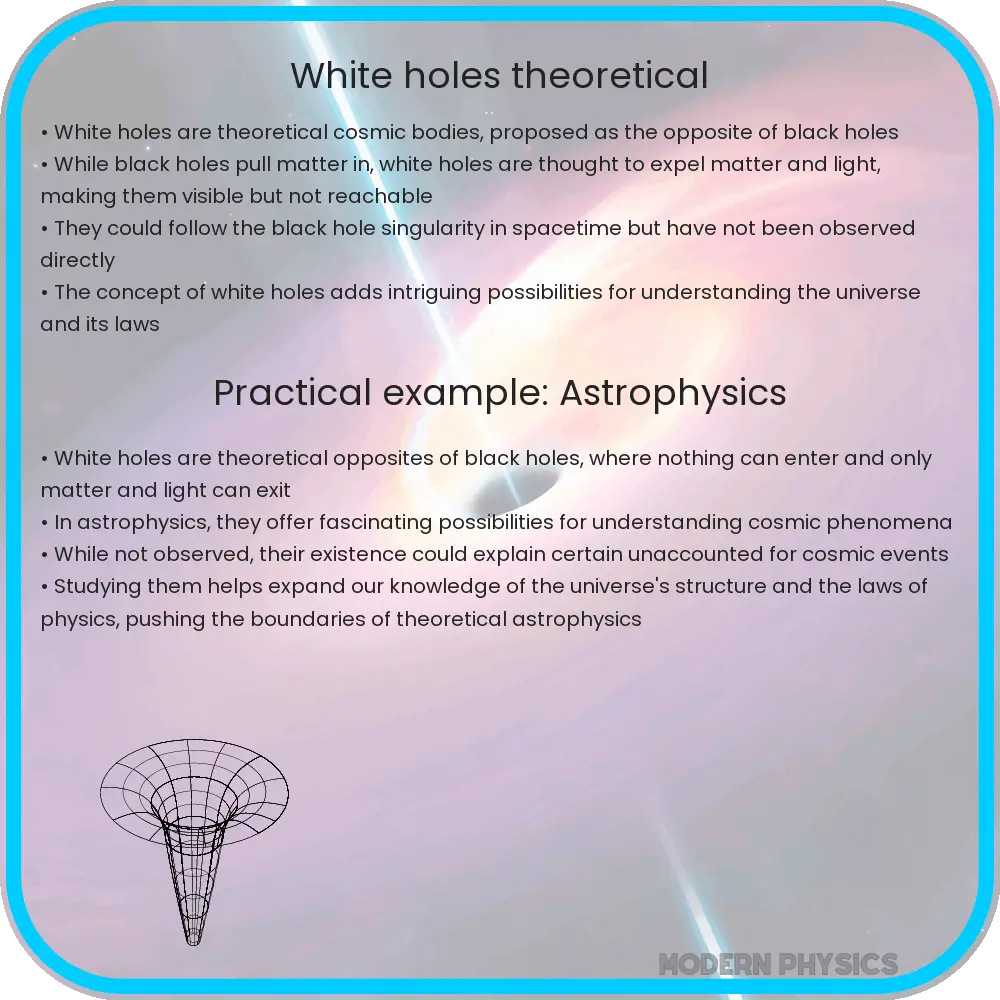Explore the enigmatic concept of white holes in astrophysics, their theoretical foundations, challenges in observation, and cosmic implications.

Exploring the Enigma of White Holes
In the vast and mysterious expanse of the cosmos, white holes stand as one of the most intriguing and speculative concepts within theoretical physics. Often considered the reverse of black holes, white holes are hypothetical regions in spacetime that, unlike their counterparts, cannot be entered from the outside, but instead expel matter and energy. This theoretical construct, rooted in the solutions of Einstein’s field equations of General Relativity, offers a tantalizing glimpse into the complex and often bewildering nature of the universe.
Theoretical Foundations
The concept of white holes is derived from the Schwarzschild solution to Einstein’s General Relativity equations. The Schwarzschild metric, famously known for describing the spacetime around a non-rotating, spherically symmetric mass, predicts the existence of black holes. Interestingly, the same set of equations also posits the existence of white holes when interpreted in a time-reversed scenario. These entities are characterized by an event horizon from which light and matter can emerge, but into which nothing can enter.
White Holes and the Singularity Conundrum
A key aspect of white holes is their association with singularities, points in spacetime where density becomes infinite and the laws of physics as we know them cease to function. In the context of black holes, this singularity is concealed within the event horizon, rendering it imperceptible to the outside observer. Conversely, the singularity associated with a white hole could, in theory, be visible, a notion that defies our current understanding of physics and challenges the cosmic censorship hypothesis.
Relativistic Jet Emissions and White Holes
One of the most compelling arguments for the possible existence of white holes comes from observations of relativistic jets – highly concentrated streams of particles that are ejected from certain astronomical objects at near-light speeds. Some scientists speculate that these jets could be a manifestation of white holes, where instead of absorbing matter, these regions are expelling it at tremendous speeds. However, this theory remains highly speculative and controversial within the scientific community.
As a purely theoretical construct, white holes have not been observed in the universe. The primary challenge lies in their transient nature; according to some models, a white hole would be incredibly short-lived, making their detection nearly impossible with current technology. Moreover, distinguishing a white hole from other astronomical phenomena, such as quasars or supernovae, presents significant observational challenges.
Is this conversation helpful so far?
Challenges in Observing White Holes
The main obstacle in studying white holes is their hypothetical and transient nature. Theoretical models suggest that if they do exist, white holes would have a very brief lifespan, making them extraordinarily elusive to current astronomical detection methods. This transient behavior is attributed to the unstable nature of the predicted white hole singularity. Furthermore, the astronomical community faces the challenge of differentiating potential white hole events from other cosmic phenomena like quasars or supernovae, which share similar observable characteristics.
White Holes in Quantum Gravity
Recent advancements in quantum gravity have provided a new perspective on the discussion of white holes. Some theories, like Loop Quantum Gravity, propose that the singularity inside a black hole could transform into a white hole due to quantum mechanical effects. This transformation could potentially resolve the information paradox associated with black holes, suggesting that information isn’t lost but rather expelled through a white hole. However, these ideas remain purely theoretical and are a subject of ongoing research and debate in the field of quantum cosmology.
Implications for the Big Bang Theory
White holes have also been speculated to have connections with the Big Bang theory. Some theorists propose that the Big Bang itself could be the result of a white hole explosion. In this context, the universe’s origin would be linked to a white hole singularity, suggesting a cyclical model of universe creation and destruction. This radical idea, while intriguing, remains highly speculative and lacks empirical evidence.
Conclusion
In conclusion, while white holes present a captivating concept within theoretical astrophysics, their existence remains unverified and speculative. Their study, however, is crucial in pushing the boundaries of our understanding of the universe, challenging existing paradigms in physics, and sparking imaginative and innovative theories. As our technological capabilities in astronomical observations and our theoretical frameworks in quantum mechanics and general relativity evolve, the mystery of white holes may one day be unraveled, potentially unveiling new and profound insights into the nature of our universe.
